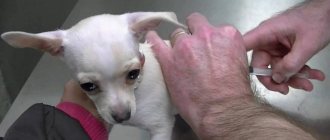With the help of the brain, our four-legged pets process incoming information and control their movements and reactions. Any disturbances in the functioning of this important organ are fraught with loss of social skills and loss of normal functioning. The most dangerous pathologies that cause the death of brain cells in dogs include hydrocephalus.
What is hydrocephalus?
Hydrocephalus most often occurs in puppies. Due to the rapid growth of the body, the cranial bones do not keep up with the brain, so an excessive amount of cerebrospinal fluid accumulates in their cavities. Gradually increasing pressure leads to the death of nerve cells and degradation of brain activity.
Mechanical damage and infections can cause a similar disorder, so adult animals are also not immune from the disease. Regardless of the cause, the pathology poses a serious threat to life and requires immediate treatment.
Treatment of hydrocephalus
Unfortunately, congenital hydrocele of the brain cannot be treated. All medical actions are aimed only at alleviating the symptoms of the disease and slowing its progression. The main goal of treating hydrocephalus is to restore the balance of fluid production and absorption in the brain.
Veterinarians also offer a surgical solution such as a ventriculoperitoneal shunt. The purpose of the operation is to artificially remove excess cerebrospinal fluid into the abdominal cavity by implanting a shunt, which is a thin polymer tube.
A catheter with a valve is mounted into the cerebral ventricles through a burr hole. Next, the tube is brought to the surface of the skull, passes subcutaneously through the head and chest, and is brought out into the abdominal cavity, where excess cerebrospinal fluid will constantly drain. The operation is quite complex and expensive, there are risks of infection and premature euthanasia.
The owner should take the following precautions for a shunted dog:
- exclude active games with other pets;
- pick up the dog with extreme caution;
- prevent your pet from jumping from high furniture;
- monitor the sick ward around the clock;
- be periodically observed in a veterinary clinic by the attending physician.
When conservative and surgical treatment is pointless, the humane solution is to euthanize the dog. For any questions regarding the treatment of hydrocephalus in Chihuahuas, it is advisable to consult a veterinarian.
Have you ever encountered such a problem as hydrocephalus in a Chihuahua in your life? What actions were taken, and how did this affect the course of the puppy’s illness?
All the secrets of training a Chihuahua are in our author's book! Raising a smart and obedient Chihuahua in 30 days is real! See for yourself!
Hydrocephalus is a congenital disease of dogs, characterized by excessive formation and accumulation of cerebrospinal fluid in the cerebral ventricles. At the same time, the total volume of the brain remains unchanged, therefore, due to increased pressure in the cerebral ventricles, the amount of nervous tissue decreases. This leads to severe manifestations of the disease.
Causes of pathology
Depending on the cause, the disease can be congenital or acquired. In the first case, the circulation of cerebrospinal fluid is disrupted due to:
- abnormally narrowed ducts (ventricles of the brain);
- excessively active secretion;
- intrauterine infection.
Symptoms of congenital pathology appear from 1 month to 1 year. Later detection is typical for the acquired type, when damage to the ducts is explained by the following reasons:
- traumatic brain injuries that displace brain tissue under the pressure of hematomas;
- infections accompanied by inflammatory processes;
- neoplasms that increase intracranial pressure.
Treatment of hydrocephalus in dogs is successful only in the initial stages - until irreversible complications appear. The earlier the first symptoms are detected, the greater the chance of a favorable prognosis.
Treatment method and prognosis
Once the diagnosis is made, the doctor prescribes treatment for hydrocephalus. It is carried out in a complex and includes taking diuretics, the action of which is aimed at removing excess fluid from the body. Prescribed:
- Prednisolone: 0.25-0.5 MK/1 kg of weight 2 times a day every 12 hours.
- Furosemide: 0.4-4 MK/1 kg 1 time per day.
- Acetazolamide: 10 MK/1 kg 4 times a day every 6 hours.
- Omeprazole: 10-20 MK/1 kg 1 time per day.
The dosage and course of taking medications are determined by the doctor depending on the weight of the animal, the condition and individual characteristics of the body. The owner must strictly comply with the treatment conditions, since uncontrolled use of medications can have a detrimental effect on the dog’s health and lead to numerous side effects.
Since convulsions are common in sick puppies, anticonvulsant medications are given. To strengthen the immune system, vitamin complexes are prescribed.
But conservative therapy is often ineffective, so there is a need for surgical intervention. The operation involves the introduction of a shunt for the outflow of cerebrospinal fluid.
After surgery, your veterinarian may prescribe corticosteroid hormone therapy.
Contraindications to surgical intervention include exhaustion of the body, advanced hydrocephalus, severe changes and deformation of the skull.
In most cases, the prognosis for hydrocephalus is unfavorable, since even with timely shunting it is impossible to completely get rid of the pathology. It is not always possible to restore vision and motor function. In addition, the risk of death during surgery is very high.
Symptoms and signs
One of the first symptoms of hydrocephalus in dogs is wandering or running in circles for no reason, reminiscent of catching a tail. In such a situation, the animal is not distracted by stimuli even during direct collisions and stubbornly moves along one route.
Over time, the symptoms increase:
- strabismus and blurred vision;
- disproportionate enlargement of the head and depletion of other parts of the body;
- unexpected falls with the head thrown back and tilted to a certain side in between attacks;
- seizures and convulsions affecting one or more parts of the body.
The patient's behavior becomes aggressive or apathetic. The animal runs madly around the house, gnawing at all the objects it gets in its way, or looks indifferently at one point, ignoring the owner’s commands.
An increase in head size is not typical only for representatives of large breeds. When sick, they feel depressed, refuse to eat and lose a lot of weight. But even these symptoms are enough to consult a veterinarian.
Possible complications
If you do not begin timely treatment of hydrocephalus, an increase in the volume of cerebrospinal fluid will lead to massive damage and death of nerve cells. The result of the destructive effects of pathology are paralysis, seizures and various nervous disorders.
The article describes the topic: “Hydrocephalus in dogs” with comments from professionals and a list of interesting literature on the topic.
Home / Veterinary Encyclopedia / Neurology /
Hydrocephalus is a congenital disease of dogs, characterized by excessive formation and accumulation of cerebrospinal fluid in the cerebral ventricles. At the same time, the total volume of the brain remains unchanged, therefore, due to increased pressure in the cerebral ventricles, the amount of nervous tissue decreases. This leads to severe manifestations of the disease.
Breeds at risk
The likelihood of developing the disease is influenced by breed. Most often, representatives of small breeds are affected, acquiring the disorder from birth. For representatives with larger dimensions, the situation is the opposite. In their case, the disease almost always turns out to be acquired.
Small breeds
Hydrocephalus occurs in Chihuahuas, Pekingese, miniature poodles and Yorkshire terriers - miniature dogs with small skulls. They are characterized by a congenital type of pathology associated with a discrepancy between the sizes of the brain and cranium. The first alarming symptoms appear 4-5 weeks after birth.
Large breeds
Pets with large dimensions get sick much less often. In their case, the cause of the disorder lies in concomitant diseases: infections or neoplasms. If preventive examinations and timely treatment are neglected, any pet can encounter pathology. Only the course of the disease will differ, excluding head deformation due to intracranial pressure.
Diagnosis at the veterinarian
The symptoms of the disease are similar to dropsy, so first of all the animal must be examined at a veterinary clinic. To make a diagnosis use:
- analysis of biological fluids (blood, urine, liquor);
- Ultrasound, encephalography or X-ray of the brain;
- MRI and CT.
An ultrasound is only available if there is a fontanel (that is, in small puppies). In other cases, bones interfere with the passage of ultrasound.
Diagnosis of the disease
Hydrocephalus in Chihuahuas usually occurs in puppies under 12 months of age. The disease, as a rule, is congenital, but can also be acquired at any age as a result of severe traumatic brain injury, which led to the development of intracranial hematoma and, as a consequence, dropsy. In addition, acquired hydrocephalus in Chihuahuas can be the result of vitamin A deficiency, parainfluenza, or a malignant tumor.
If one or more symptoms of dropsy appear in a puppy, you should immediately contact a veterinary clinic for up-to-date medical tests. Timely detection of hydrocephalus in the early stages will make it possible to slow down the progression of the disease using medical means, thereby prolonging the life of the pet.
To confirm the diagnosis, the veterinarian will perform an ultrasound examination of the cerebral ventricles, electroencephalography (EEG), magnetic resonance imaging (MRI) or computed tomography (CT) of the animal's brain. In some cases, an X-ray of the skull (craniography) is done.
Is there a treatment?
Drug treatment for hydrocephalus in dogs rarely produces positive results. In most cases, the improvement in well-being is temporary, so veterinarians strongly recommend surgery.
Medication method
Taking medications is aimed at eliminating the root cause and reducing intracranial pressure by removing excess cerebrospinal fluid. For this purpose, sick animals are prescribed:
- antibiotics that suppress infection activity;
- anti-inflammatory, relieving existing swelling;
- diuretics, stimulating the outflow of accumulated fluid;
- glucocorticosteroids, which reduce the production of cerebrospinal fluid;
- anticonvulsants, preventing involuntary muscle contractions;
- vitamins and minerals necessary to maintain a normal level of vital activity.
Taking these medications suppresses symptoms, allowing you to achieve stable remission for many years. This therapy is used in the early stages of an acquired disease, as well as in the presence of contraindications to surgery.
If the pathology turns out to be congenital, then the pet can only be cured surgically. In this case, the probability of recovery reaches 90%.
Carrying out the operation
Ventriculoperitoneal shunting is used to drain excess fluid. The essence of this operation is the subcutaneous placement of a flexible tube with a pump. With its help, excess cerebrospinal fluid is removed from the ducts into the abdominal cavity, where they are absorbed into the internal organs. By reducing intracranial pressure, the animal's condition improves.
The operation is contraindicated in severe exhaustion and acute forms of infectious diseases. For this reason, symptomatic therapy is used before surgery.
What can you do at home?
Self-medication is ineffective, so the owner must not miss the moment and contact a veterinarian at the first sign of discomfort. Otherwise, the pet will die from compression of the brain.
After bypass surgery, it is necessary to protect the operated dog as much as possible. You will have to wear the drainage tube for the rest of your life, so you must not allow it to become deformed or dislodged. To avoid complications, you will need to follow the following recommendations:
- Limit activity and stop playing together with other animals. You will have to forget about participation in sports disciplines and hunting.
- Handle your pet with extreme caution, being careful not to touch the structure under its skin.
- Visit your veterinarian regularly to ensure that the tube is not clogged or there is abscess at the site where it was inserted.
The prognosis for your pet will depend not only on the work of the surgeon, but also on compliance with all the listed recommendations. Neglecting at least one of them can significantly aggravate the existing situation.
How is hydrocephalus treated in dogs?
If your pet exhibits the above signs and symptoms, it should be taken to an experienced veterinarian immediately. The disease is diagnosed using various research methods: from ultrasound to computed tomography of the head. Treatment of hydrocephalus in dogs involves drug and surgical therapy. It all depends on the severity of the disease and the reasons for its occurrence. The disease is similar in appearance to dropsy.
ATTENTION! Drug therapy can be beneficial in some cases. But, unfortunately, the relief will be short-lived. It is during this period of improvement that it is advisable to undergo surgery. You can't do without it.
When the symptoms of illness are still mild and the diagnosis was made on time, drug therapy is used. First of all, drugs are prescribed that can reduce intracranial pressure. Dogs are also prescribed diuretic drugs, antibiotics, and glucocorticoids. These are mainly Prednisolone, Furosemide, Acetazolamide, Omeprazole, etc. All these drugs are recommended to be administered with a gradual reduction in therapeutic portions to the minimum required to maintain therapeutic results.
In general, the use of such medications requires strict adherence to the dosage time. This will help, first of all, to obtain the desired impact, as well as protect the animal from their side effects. It should also be taken into account that therapy with these medications can cause a lack of various microelements. Therefore, in addition, it is important to take vitamins.
ATTENTION! It is strictly forbidden to take drugs that are classified as diuretics constantly and uncontrollably. When carrying out therapy with them, you should adhere to the prescribed healing gap. If convulsive activity occurs, the animal is also prescribed anticonvulsant medications.
Such treatment, although it provides a certain level of relief, cannot completely get rid of this disease. In addition, it is not suitable for long-term therapy. The solution is surgery in the form of ventriculoperitoneal shunting. The essence of the operation is that with the help of a shunt (tube) the brain and abdominal cavities are connected and thus it is possible to drain excess cerebrospinal fluid from the brain of the head.
It goes without saying that the dog will have to be with this tube constantly for the rest of its life. In this regard, owners of such animals must comply with the following rules:
- do not allow your pet to be excessively active, playing with other dogs (it is better not to allow this at all);
- carefully pick up your pet so as not to harm him;
- Regularly visit the veterinary clinic with him to monitor the condition of the shunt, which tends to become clogged from time to time.
ATTENTION! Surgical installation of a shunt designed to drain cerebrospinal fluid in case of hydrocephalus is the most effective measure that can alleviate the dog’s condition. Your pet will feel 90% better. But the disadvantage of such a device is that it can move, get damaged or cause rotting at the place of its installation. Therefore, constant monitoring of the dog by a veterinarian is necessary.
Forecasts for the future, possible complications
A favorable prognosis is possible only with timely treatment. Congenital disease cannot be completely cured. It can only be slowed down, and the only effective method for this is bypass surgery.
An advanced form of the pathology is fraught with loss of vision, loss of motor function, the development of nervous disorders and the gradual death of nerve cells. If at the time of diagnosis the patient’s skull is severely deformed, then the operation and subsequent risks are considered unjustified. The animal is saved from upcoming or existing suffering by euthanasia.
Congenital hydrocephalus is incurable, so owners of pets at risk should be more attentive to changes in their behavior. The disease, detected at an early stage, is successfully controlled. Despite some limitations after bypass surgery, the operated dog can live a long and happy life.
The article is for informational purposes only. Contact your veterinarian!
Causes of the disease
Hydrocephalus is classified as a congenital disease, although acquired cases also occur in medical practice, but to a much lesser extent. Pathology occurs due to disturbances in the activity of the ventricles of the brain. CSF, a constantly circulating fluid, accumulates in them, which in turn leads to contraction of nerve cells.
To date, the exact causes of congenital hydrocephalus have not been established. If we are talking about an acquired pathology, then the provoking factors are, first of all, brain tumors and inflammatory processes in the body.











